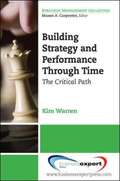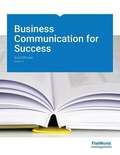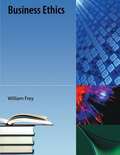- Table View
- List View
American Government and Politics in the Information Age
by David L. Paletz Diana Owen Timothy E. CookAmerican Government and Politics in the Information Age by Paletz, Owen, and Cook, is a comprehensive introduction to the vital subject of American government and politics. It is a comprehensive introduction to American politics and government; it covers all the basics. The text: * introduces the intricacies of the Constitution, the complexities of federalism, the meanings of civil liberties, and the conflicts over civil rights; * explains how people are socialized to politics, acquire and express opinions, and participate in political life; * describes interest groups, political parties, and elections--the intermediaries that link people to government and politics; * details the branches of government and how they operate; * shows how policies are made and affect people's lives.
Anatomy & Physiology
by OpenStaxHuman Anatomy and Physiology is designed for the two-semester anatomy and physiology course taken by life science and allied health students. The textbook follows the scope and sequence of most Human Anatomy and Physiology courses, and its coverage and organization were informed by hundreds of instructors who teach the course. Instructors can customize the book, adapting it to the approach that works best in their classroom. The artwork for this textbook is aimed focusing student learning through a powerful blend of traditional depictions and instructional innovations. Color is used sparingly, to emphasize the most important aspects of any given illustration. Significant use of micrographs from the University of Michigan complement the illustrations, and provide the students with a meaningful alternate depiction of each concept. Finally, enrichment elements provide relevance and deeper context for students, particularly in the areas of health, disease, and information relevant to their intended careers.
AP Environmental Science
by University of CaliforniaText associated with University of California College Prep (UCCP) Advanced Placement (AP) Environmental Science online course.
Applied Finite Mathematics
by Rupinder SekhonThis module contains all 10 chapters of the Applied Finite Mathematics open textbook by Rupinder Sekhon.
The Basic Elements of Music
by Catherine Schmidt-JonesExplanations (suitable for any age) of the basic elements of music, with suggested activities for introducing the each concept to children at early elementary school level. The course may be used by instructors not trained in music; all necessary definitions and explanations are included.
The Basics of General, Organic, and Biological Chemistry
by David W. Ball John W. Hill Rhonda J. J. ScottThe Basics of General, Organic, and Biological Chemistry by David W. Ball, John W. Hill, and Rhonda J. Scott is a new textbook offering for the one-semester GOB Chemistry course. The authors designed this book from the ground up to meet the needs of a one-semester course. It is 20 chapters in length and approximately 350-400 pages; just the right breadth and depth for instructors to teach and students to grasp. In addition, The Basics of General, Organic, and Biological Chemistry is written not by one chemist, but THREE chemistry professors with specific, complimentary research and teaching areas. David W. Ball's specialty is physical chemistry, John W. Hill's is organic chemistry, and finally, Rhonda J. Scott's background is in enzyme and peptide chemistry. These three authors have the expertise to identify and present only the most important material for students to learn in the GOB Chemistry course. These experienced authors have ensured their text has ample in-text examples, and "Test Yourself" questions following the examples so students can immediately check their comprehension. The end-of-chapter exercises will be paired, with one answered in the back of the text so homework can easily be assigned and self-checked.
Building Strategy and Performance
by Kim WarrenThe fundamental challenge facing business leaders is to drive performance into the future--the dynamics of strategy. To tackle this effectively, they need a clear understanding of what causes performance to improve or deteriorate and what power they have to change this trajectory for the better. Without this understanding, they risk making poor choices about their future--failing to exploit promising opportunities, pursuing unachievable aims, or falling victim to competitive and other threats. Building Strategy and Performance Through Time sets the agenda for building business strategy in powerful, actionable, and accessible terms. It gives executives clear frameworks for answering three fundamental questions: * Why is our business performance following its current path? * Where is it going if we carry on as we are? * How can we design a robust strategy to transform this future? The existing strategy tools most widely used help guide management's choices about where to compete--which customers to serve, with what products and services, and how to deliver those products and services to those customers effectively and profitably. While this choice is important, it is not often changed in any fundamental way; having found a reasonably strong and profitable position on these issues, few firms will, or should, set off in a new direction. But there is still much to be done to deliver that strategy, powerfully and sustainably over time. Many decisions need to be made, continually and holistically, across all functions of the business and adapted as conditions change from month to month and year to year. Pricing, product development, marketing, hiring, service levels, and other decisions cannot be made in isolation but must take into account other choices being made, elsewhere and at different times. Building Strategy and Performance Through Time explains a reliable, practical method, known as strategy dynamics, that creates a living picture of how an enterprise actually works and delivers performance. This picture shows exactly where the levers are that management controls and how to choose what to do, when, and how much, to accomplish your specific goals. It shows, too, how the same approach can be used to defeat competitors, cope with other outside forces, and keep delivering performance.
Business Communication for Success
by Scott McleanThis book is suited for Business Communication courses, but is also appropriate for Business English, Business Presentation, Professional Communication courses. Scott McLean brings his authoring expertise to this new communications textbook. Scott has authored textbooks in the areas of Speech Communication, Interpersonal Communication and Public Speaking. Business Communications for Success benefits from Scott's extensive understanding of how students learn the art of effective communication. Students are provided ample opportunity to engage with the concepts, vocabulary and models covered in the text, including role-playing exercises, journal writings, case studies, small-group activities, games, and self-assessment activities.
Business Communication for Success
by Scott McleanThis book is suited for Business Communication courses, but is also appropriate for Business English, Business Presentation, Professional Communication courses. Scott McLean brings his authoring expertise to this new communications textbook. Scott has authored textbooks in the areas of Speech Communication, Interpersonal Communication and Public Speaking. Business Communications for Success benefits from Scott's extensive understanding of how students learn the art of effective communication. Students are provided ample opportunity to engage with the concepts, vocabulary and models covered in the text, including role-playing exercises, journal writings, case studies, small-group activities, games, and self-assessment activities.
Business Communication for Success (Canadian Edition)
by Scott Mclean Murray MomanThis book is suited for Business Communication courses taught in Canada, but is also appropriate for Business English, Business Presentation, Professional Communication courses. The Canadian version was adapted by Murray Moman to include proper spelling and grammar for the Northern Territories. In addition, the examples are taken from Canadian companies and situations so students in Canada can truly relate to the textbook content.
Business English for Success
by Scott McleanBusiness English for Success is a creative solution to a common challenge across Business Communication courses: Business English or Business Presentations? Some classes place an equal emphasis on oral and written communication. If that's the case for you check out our free online text Business Communication for Success. If, however, your class places the emphasis squarely on written communication and writing proficiency, then Business English for Success is for you. Business English for Success provides instruction in steps, builds writing, reading, and critical thinking, and combines comprehensive grammar review with an introduction to paragraph writing and composition. This step-by-step approach provides a clear path to student-centered learning. A wide range of writing levels and abilities are addressed, helping each student prepare for the next writing or university course.
Business Ethics
by William FreyBusiness Ethics is a derived copy from the Corporate Governance course previously published in Connexions. While many courses using this title place emphasis on applying classical philosophical and ethical theory, this course's approach is decidedly interdisciplinary and practical. It is not designed as a socio-humanistic elective, a service philosophy course, or even an applied philosophical ethics course but as a laboratory, skills-based course where students develop, practice, and refine decision-making and problem-solving strategies that they will carry with them into the world of business practice. Emphasis has been placed on responding to the four ethical themes identified by the AACSB ethics task force: Ethical Leadership, Ethical Decision-Making, Social Responsibility, and Corporate Governance. Modules include (1) theory building activities (responsibility, rights, virtue), (2) problem specification frameworks emphasizing socio-technical system building and analogies with design, (3) specific modules responding to AACSB ethics themes (moral ecologies, corporate social responsibility, corporate governance, and a history of the modern corporation) and (4) modules that provide the course with a capstone, integrative experience (Business Ethics Bowl, Social Impact Statement Reports, and Corporate Ethics Compliance Officer Reports). While a quick glance shows that this collection holds more modules than can possibly be covered in a single semester, this approach gives the user flexibility as to the method used for integrating ethics into the business administration curriculum. Modules can be recombined into different standalone courses such as business ethics, business/government/society, or environment of organizations. Since each module can be covered independently, they can be integrated into the business administration curriculum as specific interventions in mainstream business courses in areas like accounting, finance, management, information systems, human resources or office administration. (In fact many have been written for and tested in these circumstances.) Business Ethics has been developed through the NSF-funded project, "Collaborative Development of Ethics Across the Curriculum Resources and Sharing of Best Practices," NSF SES 0551779.




